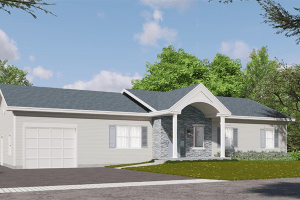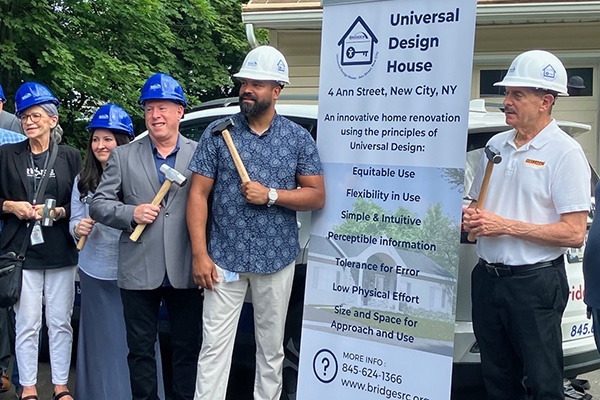|
RCBJ-Audible (Listen For Free)
|
4 Ann Street In New City Will Be Razed To Foundation, Rebuilt Into a Model House, and Put On Market To Be Sold After Tours/Workshops
By Tina Traster
Imagine buying a house that anticipates life changes?
 Carlos Martinez, executive director of BRIDGES, wants to do more than ponder this phenomenon known as ‘Universal Design.’ He and his organization are building it so you can come and see how Universal Design makes homes accessible and inclusive from the outset, rather than retrofitting or remodeling a house later to accommodate for people with disabilities or special needs.
Carlos Martinez, executive director of BRIDGES, wants to do more than ponder this phenomenon known as ‘Universal Design.’ He and his organization are building it so you can come and see how Universal Design makes homes accessible and inclusive from the outset, rather than retrofitting or remodeling a house later to accommodate for people with disabilities or special needs.
BRIDGES, a champion of independent living, spent the last three years raising donations to build a house that will showcase the concept of Universal Design. The organization in 2024 bought 4 Ann Street in New City, a 1,035 square-foot ranch, for $435,000. The house, bought free and clear without a mortgage, will be razed to its foundation and rebuilt as a model house that embodies Universal Design.
Martinez has been given construction estimates of about $400,000 to build a 2,000-square-foot house that will include such features as step-free entrances, wide doorways, lever-style handles and smart home technology, adjustable-height kitchen countertops and pull-down shelving, barrier-free bathrooms with boundary-less showers, and nonslip flooring, to name some.
Once built – construction estimates from the builder Sterling Classic of Pearl River range from three to six months — BRIDGES will open the home for six weeks for tours and workshops, inviting architects, homebuilders, designers, policy makers and the public to survey the finished concept. Then, the house, which will likely be put on the market to sell for at a market rate price, which will likely be more than $1 million. It will be open to buyers without restrictions.
“The Universal Design concept takes into account the largest selection of people, which makes sense because it allows everyone to live with freedom and dignity,” said Martinez.
Clarkstown, County officials and state officials gathered at the house site on Thursday to mark the symbolic groundbreaking.
“ADA (American With Disabilities Act) doesn’t address residential housing,” said Martinez. “People move into homes and they have to move out or retrofit. ” With Universal Design, it doesn’t cost more later; a person’s changing needs are built in from the beginning.
Universal Design creates environments that are inherently accessible to all people, regardless of age, ability, or mobility, but it prioritizes the needs of a diverse range of users, including those with disabilities, the elderly, and children. While universal design often aligns with accessibility guidelines, it goes beyond mere compliance with regulations by proactively considering the needs of all users.
Martinez explained Universal Design is as much about anticipating needs as it is about the here and now. While some aspects of a Universal Design house are there from the start, other aspects are built into the infrastructure so that they can be accessed when needed. For example, a homeowner might not need “grab bars” when purchasing a home but may need them later if they age in place. A Universal Design home anticipates needs like this by building stronger studs into the infrastructure or space in a closet that can later house an elevator. Most homes are not built for wheelchairs; when someone becomes wheelchair bound, homeowners usually add metal ramps for ingress and egress. But Universal Design starts with no-step entry for both practical and aesthetic purposes.
Broadly, Universal Design takes into consideration curb cuts that allow people in wheelchairs, those with strollers, and others with mobility aids to easily cross the street. Other features include automatic doors that allow for easy access, clear signage, which help those with visual impairments or language barriers, and voice-activated systems that help with mobility or dexterity limitations.
Martinez has been talking up this concept for years. He said the organization raised monies over time to achieve this goal. The largest donation for the project was $3,000. The project did not qualify for state grants.
Though real estate can be a risky enterprise, BRIDGES said it tapped into its well of talent. Board member Robert Bernstein, an architect with BILD Architecture, designed the plans pro bono. Gina Glasel from Howard Hanna Rand Realty brokered the house without taking a commission. Joanna Wasilewska from M4 Interiors and the Idea Center in Buffalo are collaborating on the project.
Initially, BRIDGES thought 4 Ann Street could be modified to incorporate Universal Design, but the house became a tear-down when bad mold was discovered.
Once the house is sold, BRIDGES plans to buy and convert another house for Universal Design.
“The hope is that the sale of the first one will cover our costs, and we can continue this effort by buying another house,” said Martinez. But if this turns out to be a one-off for BRIDGES, Martinez says he plans to advocate and consult on Universal Design projects.
“I plan to advocate for legislation and incentives for builders to use Universal Design,” said Martinez. “We’re hoping that we will make history right here in Rockland County.” Martinez says 4 Ann will become a laboratory to stimulate the idea and motivate others to undertake similar projects.
“I’m hoping this house will get showcased on HGTV,” he added.












